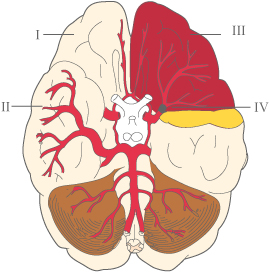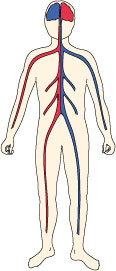Definition and causes of Stoke

I. Frontal lope II. Temporal lope III. Tissue starved of oxygen,
IV. Blood clot
A cross section of the underside of the brain and its blood
vessels. On the left side of the brain the Temporal lope is removed.
The main brain artery and its supply area is shown. A blood clot has formed and become stuck and the dark red area is starved from oxygen. This will result in paralysis and sensory disturbance on the right side of the body
Stroke is a very serious and quite common disease affecting around one in every 500 citizens each year in western countries. The incidence rises with age and men are affected more often than women.
A stroke occurs when the brain is damaged due to lack of blood supply. When the blood supply fails, nerve cells do not receive the necessary oxygen and the brain is damaged. This can happen from three reasons:
A blood clot (a lump of coagulated blood) in a brain vessel, a blood clot brought to the brain from somewhere else in the body or bleeding in the brain from a ruptured blood vessel. Around 85% of stroke cases stem from blood clots, 15% stem from bleeding often named seizures.
-
Blood clot in the brain resulting from arteriosclerosis. The blood vessels become narrow and damaged from sediments of fat and calcium - hardening of the arteries. In this plaque of lime and fatty parts the blood can become lodged and form a clot called a thrombosis which blocks the blood flow to the brain tissue.
An embolus.
A blood clot can also come from somewhere else in the body and is then called an embolus, for example from a narrowed vein in the neck, where a lump of fat, calcium and/or clotted blood breaks loose and travel to the brain. The same can happen from auricle fibrillation where the heart auricle pre accumulates clotted blood which tears away and imbeds itself when reaching a narrow vein in the brain starving the brain tissue of oxygen.
-
A blood vessel wall is ruptured.
Blood seeps into the brain tissue, resulting in a brain haemorrhage. In most cases this condition is a result of arteriosclerosis where the weakend or damaged veins ruptures more easily allowing the blood to reach the brain tissue. The symptoms are usually the same as a blood clot, but can be more dramatic and lead to unconsciousness. A number of bleeds occur during the middle meninges (subaraknoidea bleeding).
When starved of oxygen from disrupted blood supply the brain cells cannot function and quickly die. This triggers the body symptoms from the parts of the body controlled by the affected area of the brain.
Symptoms of stroke

The brain's two halves control
the functions of the body's
opposite side. Thus, a blood
clot in the brain's left side (red)
paralyzes the muscles in the right
arm and leg.
The symptoms of a stroke normally appear suddenly (minutes) and can be very scary. The symptoms often intensify over the following hours and may vary depending of which area of the brain is affected. The brain is divided into two cerebral hemispheres (halves) and each cerebral hemisphere controls the opposite side of the body. A blood clot in the left part of the brain will therefore give symptoms in the right arm and leg. Typical symptoms of a stroke are:
-
Paralysis of an arm or a leg
-
Paralysis of one half of the body or face
-
Blindness in one half of the field of vision
-
Unintelligible speech or problems understanding
-
Tingling or numbness in parts of the body
-
Dizziness and possibly fainting
-
Balance and coordination problems
There might be many other symptoms.
From the type of symptoms the doctor can determine which part of the brain has been damaged. This is because the cerebral cortex is divided into different areas, each with its own function. If for example the temporal lobe is affected the patient will have problems with speech, while dizziness and problems walking suggest a stroke in the cerebellum (small brain). Thus, a small blood clot in an important area might do greater damage to the victim than a large blood clot in a less important area of the brain.
Despite the significant damage to the brain a stroke is usually painless. However, many patients suffer headache. The symptoms will, unlike in TIA, exceed 24 hours and often much longer.
Precautions and diagnosis
If you experience stroke like symptoms, you must consult a doctor or emergency room right away. The condition is serious and rapid diagnosis and treatment is important. If you are unable to get to a doctor or an emergency room then quickly call an ambulance or ask someone to do it for you.
Upon arrival to the hospital a CT scan of the brain is performed (see image of the brain), from which it can be determined if there is a bleeding or a blood clot in the brain, and also where the damage is localized. This knowledge has implications for further treatment such as providing blood thinning medication to people with blood clots. An electrocardiogram ECG is also standard procedure to determine if the stroke is connected with heart problems.
In the case of a severe stroke, first aid on the spot might be necessary until an ambulance arrives. Although the patient might appear distant or cannot make him or herself understood, the person can often understand and keep up with everything that goes on. One should therefore try to deal calmly with the situation.
Treatment of stroke
The treatment of a stroke consists of two things: - medical & surgical treatment and rehabilitation.
Medical and surgical treatment:
The first medical examination will check and insure that the breathing, heartbeat and other vital functions are stable. The patient will undergo a CT scan as soon as possible based on which the treatment plan is decided. In the case of a blood clot some centres might administer anti coagulation treatment (thrombolysis). But this can only be done within the first few hours after the stroke. This procedure is relatively new in some countries and can cause uncontrolled bleeding. Otherwise acetylsalicyclic acid might be given to thin the blood.
If the clot comes from a narrowed carotid vein (neck vein) this can be seen by an ultrasound scan and it might be possible to insert a small tube (a stent), which expands the vein, or remove the narrowed vein section. This is to prevent new cases.
If atrial fibrillation is the cause it is important to determine this from an ECG. The next step is then blood-thinning (anti coagulation) treatment (marevan or similar) to prevent blood accumulating in the hart forkammer.
Part of the treatment after a stroke is prevention of recurrence since the risk of another stroke is considerable if the trigger cause is not removed.
Cholesterol and blood pressure will be checked during the hospital admission, and if too high treatment will start. Elevated blood pressure will be lowered with medication over time and cholesterol levels lowered in part with cholesterol-lowering medication and reorientation of the diet under the supervision of a clinical dietician or similar.
It is also very important to remove as many risk factors as possible as outlined in the section on prevention.
Rehabilitation
The rehabilitation process is very important and it can be very lengthy. The damaged brain cells will never recover, but you can train the remaining cells in the section of the brain to take over their functions.
Thus, a person with paralyzed legs, through lengthy training, might regain the ability to walk.
The process is long and demanding and will frequently involve daily training with a physiotherapist and occupational therapist, support from relatives and various tools - and a good dose of willpower in the patient.
The same applies if the patient has lost the ability to speak or other similar skills that are performed automatically.
For smaller clots symptoms often disappear within the first week, but even when there are persistent symptoms rehabilitation can provide progress after some time. Particularly in the first three months training often show very good results. There are special rehabilitation clinics in most countries, specializing in stroke just as many hospitals have departments with personnel specially trained in rehabilitation.
Prevention of stroke
Strokes arise from a combination of causes and the elimination of these causes can prevent new cases. Smoking is an important cause, and cessation will reduce the risk of new episodes.
Obesity and diabetes also increases the risk and weight loss and strict control of blood glucose levels will also lower the risk.
Hypertension with elevated blood pressure is a major risk factor.
Blood pressure control should be checked regularly if there is any suspicion of high blood pressure and medication to lower the blood pressure is essential.
The same applies to high blood cholesterol. Cholesterol levels in the blood are lowered partly by a shift to a leaner diet and partly by using cholesterol-lowering medication.
A healthy lean diet, no smoking, low to moderate alcohol consumption and frequent exercise are all essential life style ingredients to prevent the risk of a stroke.
Complications and outlook
A stroke is a serious condition, and even small blood clots are signs of underlying disease in the blood vessels that may later lead to new clots. About 1/3 of cases ends fatally while 1/3 lead to permanent damage and disability. The last 1/3 of patients make a full recovery.
For smaller strokes (blood clots) symptoms often disappear within the first week, but with larger strokes continued rehabilitation over many months is necessary to obtain results.
Bleeding usually results in more pronounced symptoms than blood clots in the beginning, while the final outcome more dependents on the size of the damage than the origin.
Przeczytaj ten artykuł w języku polskim |